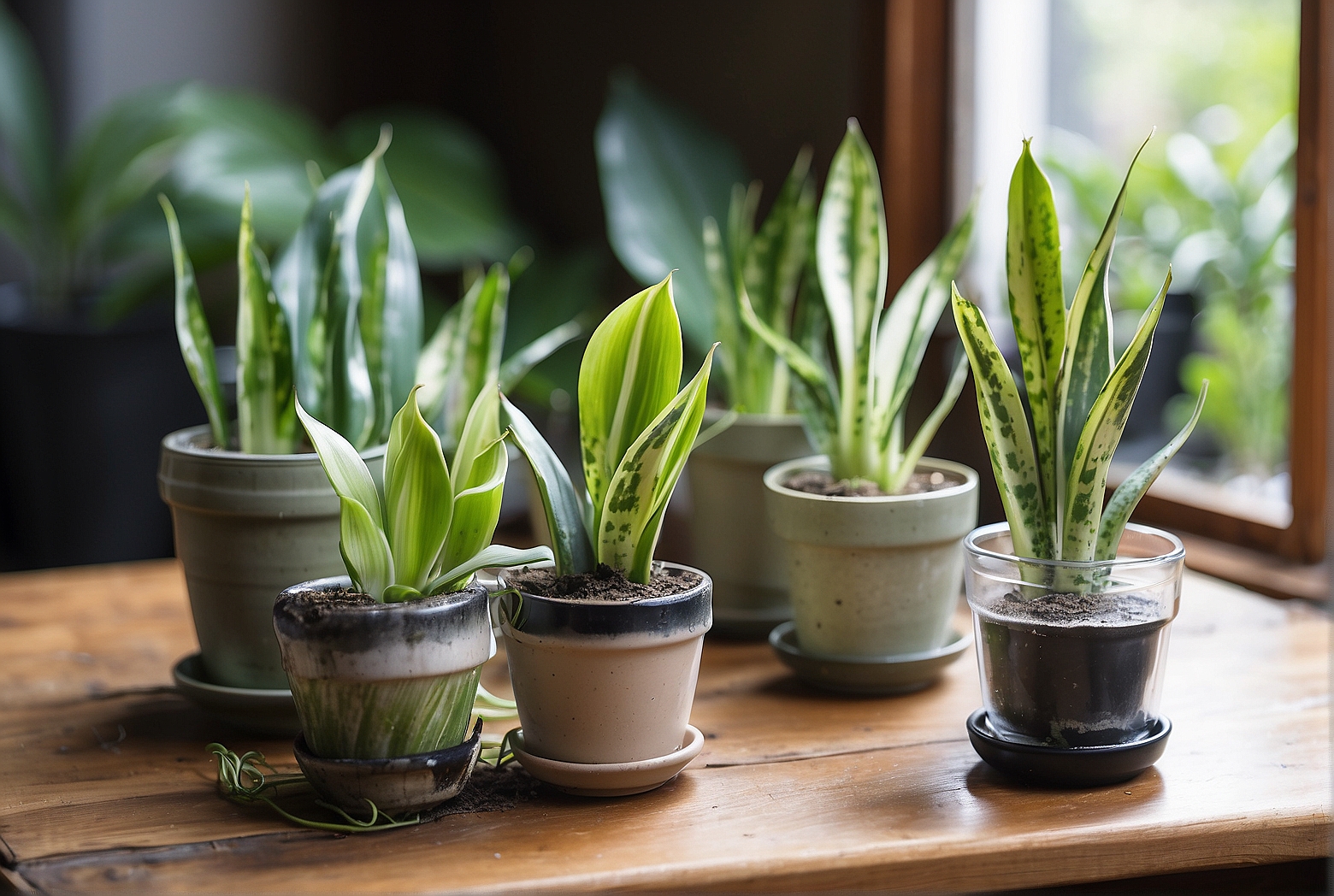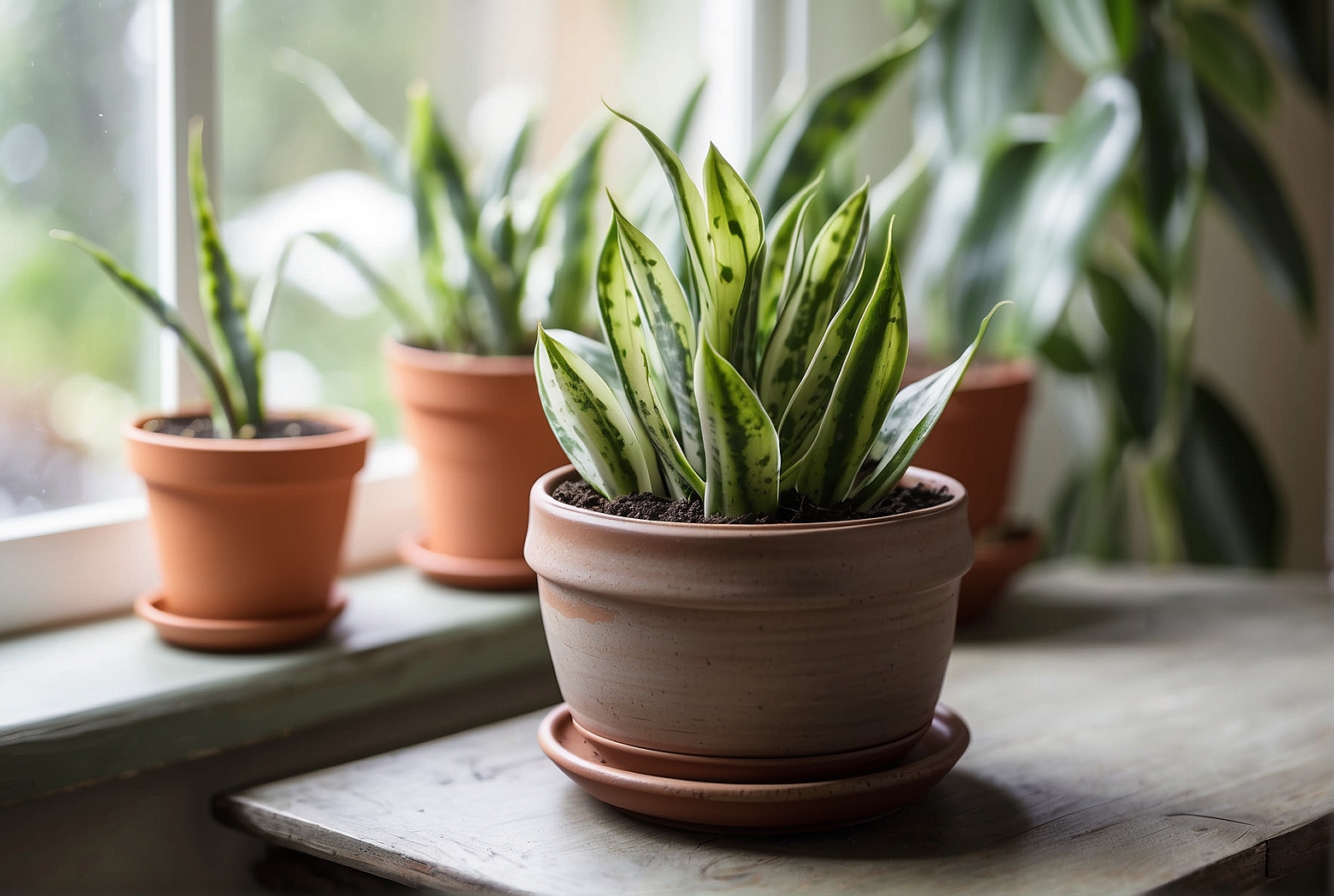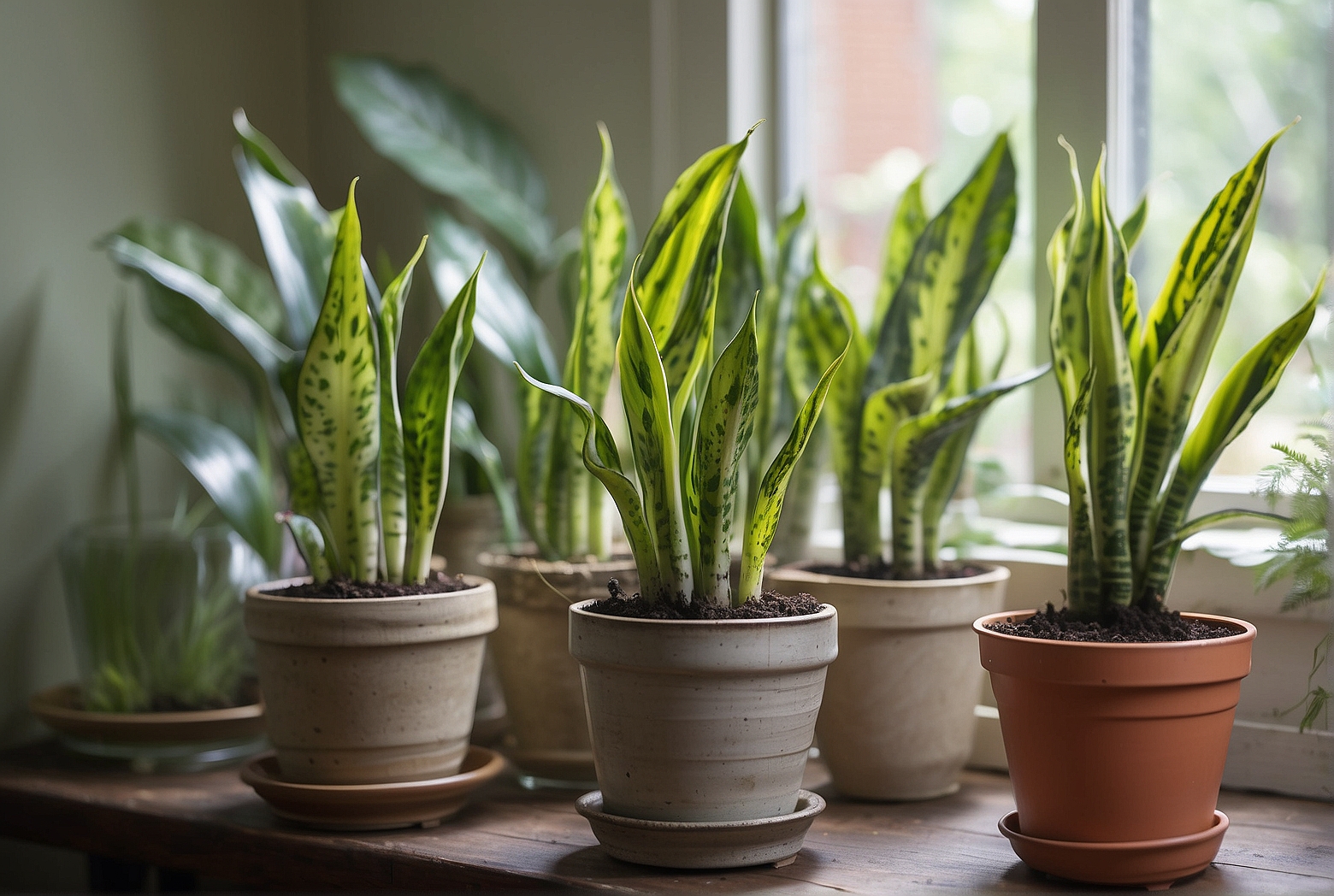Last Updated on April 19, 2024 by Tony Manhart
So, you’ve recently developed a green thumb and have been searching for your next plant-adventure. Look no further than snake plants! These incredible plants are not only known for their unique foliage, but they are also incredibly easy to propagate. In this beginner’s guide, we’ll show you the simple yet effective methods to multiply your snake plants and watch them grow into a thriving collection. Get ready to become a proud parent to a whole brood of snake plants in no time!
Understanding Snake Plants
What are Snake Plants?
Snake plants, also known as Sansevieria or Mother-in-law’s tongue, are popular indoor plants known for their upright leaves and striking appearance. These plants are native to West Africa and are revered for their ability to thrive in a variety of conditions. Snake plants have long, sword-like leaves with distinct patterns, ranging from solid green to variegated. They are not only visually appealing but also come with a variety of benefits.
Benefits of Snake Plants
Snake plants are not only beautiful additions to your home décor but also offer numerous benefits. These plants have the ability to purify the air by removing toxins and releasing oxygen. They are especially effective in filtering out harmful substances such as formaldehyde, benzene, xylene, and trichloroethylene. Additionally, snake plants have been known to improve indoor air quality by producing oxygen at night. They are also low-maintenance plants, requiring minimal care and attention, making them ideal for both experienced and novice plant enthusiasts.
Propagating Methods
Snake plants can be propagated using several methods. Each method has its own advantages and success rates, so it is important to choose the one that suits your preferences and the resources available to you.

Propagation by Division
Propagation by division is one of the easiest and most common methods to propagate snake plants. This method involves separating the plant into smaller sections, each with its own root system. Division propagation is ideal for mature snake plants that have multiple healthy shoots and are ready for expansion.
To propagate by division, start by identifying the right time to divide the plant. This is usually when your snake plant has become crowded in its current container and has multiple shoots emerging from the base. Carefully separate the plant into smaller sections, ensuring that each division has a healthy root system. Plant each division in a new pot with fresh soil and water thoroughly. Provide proper care and attention to the new divisions to ensure their successful growth.
Propagation by Leaf Cuttings
Another method of propagating snake plants is through leaf cuttings. This method involves taking a healthy leaf from the mother plant and encouraging it to root and grow into a new plant. Leaf cuttings can be a bit challenging, but with the right technique and care, they can yield successful results.
To propagate by leaf cuttings, select a mature leaf from the mother plant. Cut the leaf into several smaller sections, ensuring that each section has a portion of the leaf and a piece of the base. Allow the cuttings to dry and callus for a few days before placing them in a pot with well-draining soil. Keep the soil lightly moist and provide indirect sunlight for the cuttings to root and form new plants. With time and proper care, the leaf cuttings will develop roots and grow into individual snake plants.

Propagation by Rhizome
Propagation by rhizome is a less common but equally effective method for propagating snake plants. Rhizomes are fleshy, underground stems that grow horizontally and produce new shoots and roots. This method is especially useful if you have a mature snake plant with rhizomes that can be separated and planted as individual plants.
To propagate by rhizome, carefully dig up the mother plant and inspect the rhizomes. Make clean cuts to separate the rhizomes, ensuring that each division has a healthy shoot and root system. Plant the rhizomes in pots with fresh soil, making sure they are positioned upright and covered lightly with soil. Water the newly planted rhizomes and provide them with the necessary care to promote their growth and development.
Preparation
Before diving into the propagation process, it is important to ensure you have everything you need to successfully propagate your snake plants.
Choosing a Healthy Snake Plant
When selecting a snake plant for propagation, choose a healthy mother plant that has a strong root system and multiple shoots. Look for signs of vitality, such as vibrant green leaves, firm roots, and absence of pests or diseases. A healthy mother plant provides a good foundation for successful propagation and ensures the production of robust and thriving new plants.
Gathering the Necessary Materials
To successfully propagate snake plants, there are a few essential materials you will need:
- Sharp, clean gardening shears or scissors for division and leaf cutting propagation.
- Well-draining potting soil suitable for snake plants.
- Plant pots or containers for housing the new divisions or cuttings.
- Watering can or spray bottle for watering the newly propagated plants.
- Optional rooting hormone for leaf cuttings to promote root development (not necessary but can enhance success rates).
Gathering these materials beforehand will help streamline the propagation process and ensure you have everything you need at your fingertips.
Propagation by Division
Identifying the Right Time to Divide
The ideal time to divide your snake plant is when it becomes overcrowded in its current pot and has multiple healthy shoots emerging from the base. This usually occurs when the plant has outgrown its container or after a few years of growth. Dividing your snake plant at the right time promotes healthier growth and allows you to expand your plant collection.
Steps for Division Propagation
- Start by preparing a new pot with fresh, well-draining potting soil. Ensure the pot has drainage holes to prevent waterlogging.
- Carefully remove the mother plant from its current pot, gently shaking off excess soil from the root system.
- Inspect the root system and identify natural divisions, which are sections where shoots have emerged and formed their own root system.
- Delicately separate these divisions, taking care to keep the roots intact and minimize damage to the shoots and leaves.
- Plant each division in its own pot, positioning it at the same depth as it was in the mother plant’s pot.
- Fill the pots with potting soil, ensuring that the roots are well-covered while leaving the leaves exposed.
- Water thoroughly to settle the soil and promote root establishment.
- Place the newly divided plants in an area with indirect sunlight and moderate temperatures.
- Monitor the plants closely, ensuring they receive the right amount of water and proper care to promote their growth and development.
Caring for New Divisions
After dividing and potting your snake plant, provide the newly propagated divisions with the care they need to thrive:
- Keep the soil lightly moist but not overly saturated. Be mindful not to overwater, as this can lead to root rot.
- Place the new divisions in a location with bright, indirect sunlight. Snake plants thrive in moderate to low light conditions.
- Maintain a consistent temperature between 55-85°F (13-29°C), avoiding extreme heat or cold.
- Allow the divisions to acclimate to their new environment and provide them with proper care and attention. With time, they will establish themselves and adapt to their new pots.
Propagation by Leaf Cuttings
Selecting Suitable Leaves
When choosing leaves for propagation by leaf cuttings, select mature leaves from the mother plant that are healthy and free from damage or disease. Look for leaves that have a good size and are not too young or too old, as this can affect their success rate.
Preparing the Leaf Cuttings
To prepare the leaf cuttings for propagation:
- Use sharp and clean scissors or gardening shears to cut healthy leaves into sections, each approximately 2-3 inches long.
- Make clean, diagonal cuts, ensuring that each section has a portion of the leaf and a piece of the base or stem.
- Allow the cuttings to dry and callus for a few days in a shaded area, which helps prevent rotting and promotes rooting.
Rooting and Potting the Cuttings
Once the leaf cuttings have calloused, it’s time to encourage rooting and pot them:
- Fill small pots or containers with well-draining potting soil, leaving enough space for the leaf cuttings.
- Plant the cuttings into the soil, burying the base or stem deep enough to ensure stability.
- Water the soil lightly to settle it and provide a humid environment for the cuttings.
- Place the pots in a warm, well-lit area with indirect sunlight. Avoid direct sunlight, which can harm the delicate cuttings.
- Mist the cuttings occasionally to maintain humidity and prevent the soil from drying out completely.
- Be patient and allow time for the cuttings to root. It can take several weeks for the roots to develop and new growth to emerge.
Caring for Leaf Cuttings
To ensure the successful growth of your leaf cuttings, follow these care tips:
- Provide indirect sunlight and maintain a warm and humid environment for the cuttings.
- Avoid overwatering, as excess moisture can lead to rotting. Instead, keep the soil lightly moist.
- Be patient and resist the temptation to disturb or move the cuttings too often. Allow them time to establish and develop roots.
- Once new growth emerges and the cuttings have developed into individual plants, gradually acclimate them to their new environment and provide them with the same care as mature snake plants.
Propagation by Rhizome
Understanding Rhizomes
Rhizomes are underground stems that grow horizontally and produce new shoots and roots. Snake plants have rhizomes that can be divided and planted as individual plants, making it an effective propagation method.
Steps for Rhizome Propagation
To propagate snake plants using rhizomes, follow these steps:
- Carefully dig up the mother plant from its current pot, ensuring to minimize root disturbance.
- Gently shake off excess soil from the rhizomes without damaging their roots or shoots.
- Inspect the rhizomes and identify natural divisions that can be separated into individual plants.
- Make clean cuts to separate the rhizomes, ensuring that each division has a healthy shoot and root system.
- Fill separate pots with fresh potting soil, leaving enough space for the rhizomes to be planted vertically.
- Position each rhizome in the pot, making sure it is upright and covered lightly with soil.
- Water the newly planted rhizomes, ensuring the soil is adequately moist but not waterlogged.
- Place the pots in an area with indirect sunlight and moderate temperatures.
- Provide proper care and attention to the newly propagated rhizomes, ensuring they receive the necessary water and light for healthy growth.
Caring for Rhizome Propagation
After propagating snake plants by rhizomes, it is essential to provide the new divisions with the care they need to flourish:
- Maintain a consistent temperature between 55-85°F (13-29°C) to promote healthy growth.
- Water the rhizomes when the soil becomes slightly dry, ensuring that you do not overwater and waterlog the roots.
- Position the pots in an area with bright, indirect sunlight. Alternatively, you can place them in low to moderate light conditions if indirect sunlight is not available.
- Avoid extreme temperature fluctuations, as this can stress the rhizomes and hinder their growth.
- Monitor the divisions closely, looking out for any signs of distress, pests, or diseases. Address any issues promptly to ensure the well-being of the plants.
Caring for Newly Propagated Plants
Once you have successfully propagated your snake plants, it is crucial to provide them with optimal growing conditions to support their healthy development.
Providing Optimal Growing Conditions
Snake plants thrive in moderate to low light conditions and can tolerate a wide range of temperatures. Place your newly propagated plants in areas with bright, indirect sunlight or low to moderate light conditions, depending on their preference. Avoid placing them in direct sunlight, as this can scorch the leaves and hinder their growth. Additionally, maintain a temperature between 55-85°F (13-29°C) to ensure optimal growth.
Watering and Fertilizing
When it comes to watering snake plants, it is essential to strike a balance. These plants are drought-tolerant and prefer to be slightly underwatered than overwatered. Allow the soil to dry out between waterings, ensuring that you do not let it become bone dry. Overwatering can lead to root rot, one of the most common issues with snake plants. When watering, ensure that excess water can drain freely from the pot to prevent waterlogging. Additionally, snake plants do not require frequent fertilization. Applying a balanced houseplant fertilizer every few months during the growing season is sufficient to maintain their health and promote growth.
Pest and Disease Control
Snake plants are relatively resilient to pests and diseases. However, they can occasionally be affected by common houseplant pests such as mealybugs, spider mites, and scale insects. Regularly inspect your plants for any signs of pests, such as visible insects, webbing, or yellowing leaves. If you notice any pests, isolate the affected plant and treat it promptly with appropriate organic or chemical pest control methods. Additionally, ensure that your snake plants have good airflow and are not overcrowded, as this can increase the risk of pests and diseases.
Troubleshooting and Common Issues
Despite their resilience, snake plants can face a few common issues. Here are some troubleshooting tips for a few prevalent problems:
Yellowing or Browning Leaves
Yellowing or browning leaves can indicate overwatering, underwatering, or other issues such as root rot. Ensure that you are watering your snake plants appropriately, allowing the soil to dry out between waterings. Check the roots for any signs of rot and address the issue promptly by adjusting your watering habits and providing proper drainage.
Root Rot
Root rot is one of the most common issues with snake plants and is usually caused by overwatering or poor drainage. To prevent root rot, ensure that your plants are potted in well-draining soil and have pots with drainage holes. Additionally, adjust your watering schedule to avoid waterlogging the soil.
Pests and Diseases
Occasionally, snake plants can be affected by common houseplant pests such as mealybugs, spider mites, or scale insects. Regularly inspect your plants for any signs of pests and treat them promptly with suitable pest control methods. Maintaining good airflow, avoiding overcrowding, and providing optimal growing conditions can help prevent pest and disease issues.
Frequently Asked Questions
How long does it take for a snake plant to propagate?
The propagation timeline for snake plants can vary depending on the method used. Division propagation can yield new plants within a few weeks or months, as the divisions already have established root systems. Leaf cuttings can take several weeks to months to root and grow into new plants. Rhizome propagation can also take several weeks to months, depending on the growth rate of the newly planted divisions.
Can I use water for propagating snake plants?
While water propagation may work for some plant species, snake plants are not well-suited for this method. Snake plants prefer well-draining soil, so it is recommended to propagate them using the division, leaf cutting, or rhizome methods explained above.
Are snake plants toxic to pets?
Yes, snake plants are considered toxic to pets, including cats and dogs. The leaves of snake plants contain compounds that can cause gastrointestinal discomfort if ingested. It is important to keep snake plants out of reach of pets and ensure they cannot access the plants to prevent any potential health issues.
Can I propagate snake plants in water?
While water propagation may work for some plant species, snake plants are not well-suited for this method. Snake plants prefer well-draining soil, so it is recommended to propagate them using the division, leaf cutting, or rhizome methods explained above.
Conclusion
Propagating snake plants is a rewarding and fulfilling experience that allows you to expand your plant collection and share the beauty of these stunning plants with others. By understanding the different propagation methods and following the necessary steps, you can successfully propagate snake plants through division, leaf cuttings, or rhizomes. Remember to provide the newly propagated plants with optimal growing conditions, monitor their health closely, and address any issues promptly. With time and care, you will enjoy the rewards of propagation as your snake plants thrive and beautify your living space. Happy propagating!
Tony Manhart is a passionate gardener who has been tending to gardens for over 20 years. He takes pride in creating beautiful outdoor spaces with plants, trees, and shrubs that can thrive in any environment. He loves to share his knowledge with others and has taught classes on gardening basics and advanced techniques. He is committed to sustainability, using natural and organic methods to create and maintain gardens. He also works with local organizations to create green spaces for communities. When he’s not gardening, Tony enjoys hiking, reading, and spending time with his family.

